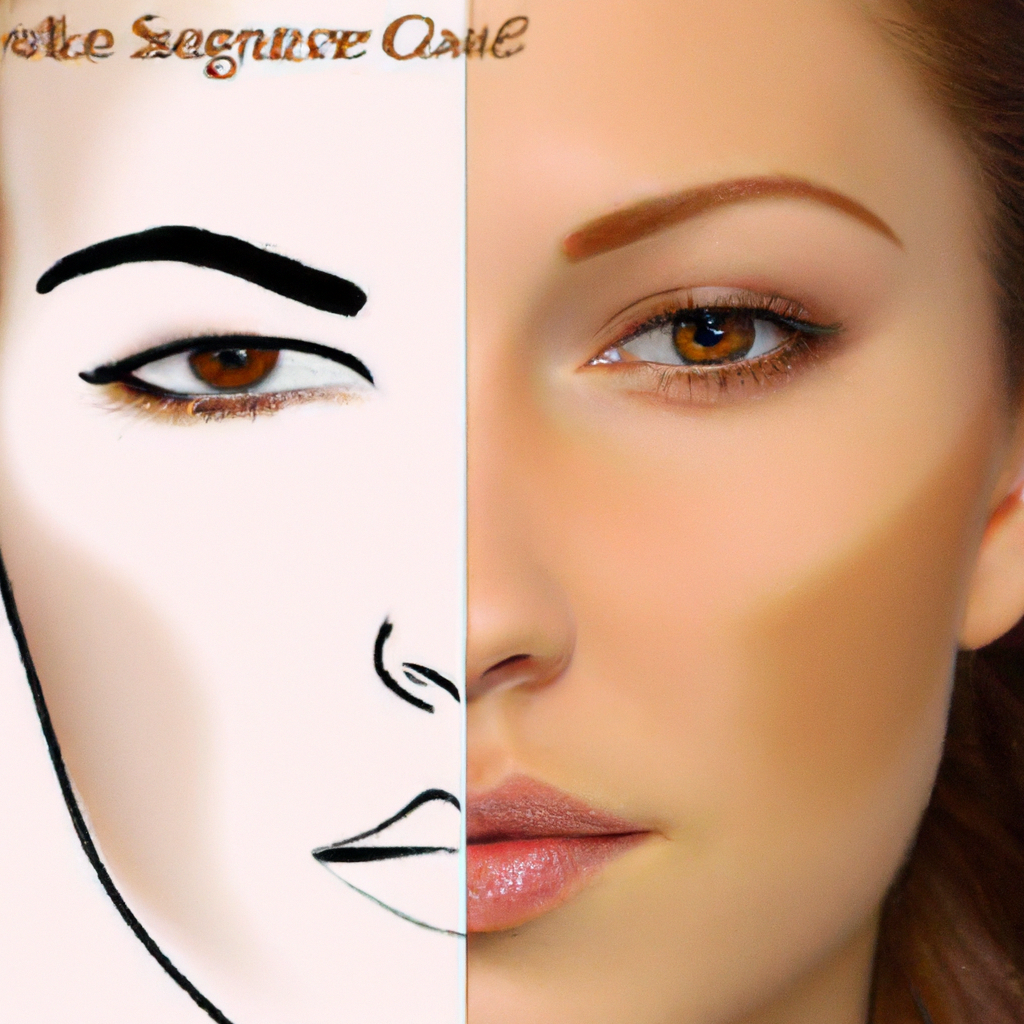Are you looking to enhance your natural beauty and bring out your best features? Look no further than the world of face contouring techniques. With the right makeup application and strategic shading, you can transform your face into a work of art. Face contouring allows you to sculpt and define your facial structure, highlighting your cheekbones, slimming your nose, and accentuating your jawline. Whether you want a subtle everyday look or a dramatic effect for a special occasion, these techniques are sure to inspire confidence and turn heads wherever you go. So, get ready to unleash your inner makeup artist and unlock the power of face contouring!
What is Face Contouring?
Definition of face contouring
Face contouring refers to the makeup technique used to enhance and define the natural features of the face. It involves the strategic use of different shades of makeup products to create shadows and highlights, emphasizing certain areas and creating the illusion of a more sculpted face shape.
Purpose of face contouring
The purpose of face contouring is to create dimension on the face, enhancing your natural features and creating a more balanced and symmetrical appearance. By strategically applying darker shades to certain areas and lighter shades to others, you can reshape your face, highlight your favorite features, and create a more polished look.
Understanding Your Facial Features
Identifying prominent facial features
Before diving into face contouring techniques, it’s essential to identify your prominent facial features. Take a close look at your face in the mirror and pay attention to areas that stand out, such as high cheekbones, a well-defined jawline, or a prominent nose. By understanding your unique features, you can tailor your contouring technique to enhance those areas.
Analyzing face shape
Determining your face shape is crucial in effectively contouring your face. The main face shapes are round, oval, square, heart-shaped, and diamond-shaped. Each shape requires different contouring techniques to achieve the desired result. Analyze the proportions of your forehead, cheeks, jawline, and chin to identify your face shape accurately.
Considering skin tone
Another important factor to consider when contouring is your skin tone. Different shades of contouring products work best with different skin tones. It’s essential to choose shades that are a few shades darker than your natural skin tone for the contouring and shades a few shades lighter for the highlighting. This creates a natural-looking illusion of shadows and highlights on the face.


Types of Face Contouring Techniques
Cream-based contouring
Cream-based contouring involves the use of cream or stick products to sculpt and define the face. Cream contour products offer a more precise application and blend effortlessly into the skin. They are ideal for dry skin types and create a natural, dewy finish.
Powder-based contouring
Powder-based contouring utilizes powdered products to create shadows and highlights on the face. Powder contours are easily blendable and provide a matte finish, making them suitable for oily skin types. They are also great for beginners as they are more forgiving and allow for easier blending.
Liquid-based contouring
Liquid-based contouring involves the use of liquid products to contour the face. Liquid contours offer a lightweight and buildable formula that blends seamlessly into the skin. They are suitable for all skin types and provide a natural-looking finish.
Choosing the Right Contouring Products
Selecting suitable shades
When choosing contouring products, selecting the right shades is crucial. For contouring, opt for a shade that is a few shades darker than your natural skin tone. This shade should create a shadow-like effect when applied to the hollows of the cheeks, temples, and jawline. For highlighting, choose a shade a few shades lighter than your skin tone to bring forward and brighten certain areas of the face.
Considering skin type
Consider your skin type when selecting contouring products. If you have dry skin, cream-based products will work best as they provide moisture and a more radiant finish. Oily skin types should opt for powder-based products as they offer a matte finish and help control excess oil. Liquid products are generally suitable for all skin types and can be adapted based on personal preference.
Researching brands and formulas
Before purchasing contouring products, take the time to research different brands and formulas. Read reviews and consider the pigment, blendability, and longevity of the products. It’s important to invest in high-quality products that will give you the best results and withstand day-to-day activities.


Prepping Your Face
Cleansing and moisturizing
Before starting your contouring routine, make sure to cleanse and moisturize your face thoroughly. This will create a smooth canvas for the makeup and help the contouring products glide on seamlessly.
Applying primer
Applying a primer is an essential step in ensuring your contouring stays in place throughout the day. Primer creates a smooth and even base for the makeup and helps control oil production, making your contouring last longer.
Choosing the right tools
Having the right tools can make a significant difference in your contouring application. For cream-based contours, consider using a damp makeup sponge or a small, dense brush for precise application. For powder-based contours, opt for a fluffy brush that allows for seamless blending and diffuses the product evenly.
Step-by-Step Guide to Face Contouring
Concealing and highlighting
Start by applying your foundation and concealer as usual. Use a concealer that is a few shades lighter than your natural skin tone to highlight the high points of your face, such as the under-eye area, the center of the forehead, the bridge of the nose, and the chin. Blend the concealer well for a seamless finish.
Defining cheekbones
To define your cheekbones, apply a contour shade to the hollows of your cheeks, starting from the outer corner of the cheek and blending towards the center of the face. Use a light hand and build up the intensity gradually for a natural-looking effect. Blend the contour shade upward towards the ears to create a lifted appearance.
Slimming the nose
To slim the nose, apply a thin line of contour shade on each side of the nose. Start from the inner corner of the eyebrows and blend downwards towards the tip of the nose. Use a smaller brush for precise application and blend well for a seamless transition.
Enhancing the jawline
To enhance the jawline, apply contour shade along the jawline, starting from the ears towards the chin. Blend the product well to create a defined and sharp jawline. Pay attention to the area under the chin as well for a more sculpted look.
Flattening the forehead
To create the illusion of a flatter forehead, apply a contour shade along the hairline, starting from the temples towards the center of the forehead. Blend well to create a natural shadow effect.
Softening the chin
To soften the appearance of a prominent chin, apply a lighter shade of contour or foundation to the center of the chin and blend downwards towards the neck. This will help create the illusion of a smoother and less prominent chin.


Blending and Buffing Techniques
Using brushes and sponges
When blending your contour, it’s important to use the right tools. Brushes and makeup sponges are both effective options. Brushes provide more control and precision, while sponges create a seamless and airbrushed finish. Experiment with different tools to find which one works best for your desired result.
Applying light pressure
When blending your contour, apply light pressure and use gentle sweeping motions. Avoid pressing too firmly as this can create harsh lines or remove the product entirely. The goal is to create a seamless transition between the contour and your foundation.
Achieving a seamless finish
To achieve a seamless finish, continue blending until there are no harsh lines or visible edges. Take your time and blend the product thoroughly, especially at the edges where the contour meets the highlighter. The key is to create a natural-looking effect that enhances your features rather than looking overly dramatic.
Contouring Tips for Different Face Shapes
Round face shape
For a round face shape, focus on creating more definition and angles. Apply contour shade along the temples and under the cheekbones to create a slimmer appearance. Make sure to blend well to avoid any harsh lines.
Oval face shape
Oval face shapes are generally well-balanced and do not require extensive contouring. Focus on enhancing your natural features, such as the cheekbones and jawline, with a subtle contour shade.
Square face shape
To soften the angles of a square face shape, focus on contouring the jawline and forehead. Apply contour shade along the hairline and jawline, blending well to create a more rounded and feminine appearance.
Heart-shaped face
For a heart-shaped face, contouring the forehead and jawline can help create more balance. Apply contour shade along the hairline and under the jawline to soften the angles and create a more harmonious look.
Diamond-shaped face
To enhance the features of a diamond-shaped face, contour the temples and under the cheekbones. This will help create a more defined and sculpted appearance. Blend well to avoid any harsh lines.


Common Mistakes to Avoid
Using the wrong shades
One common mistake in face contouring is using shades that are too dark or too light for your skin tone. Always test the shades on your skin before purchasing and choose shades that are the most natural-looking and complementary to your complexion.
Applying too much product
Another mistake is applying too much contour or highlighter product. Remember that less is more, and build up the intensity gradually. It’s easier to add more product if needed than to remove excess product.
Skipping the blending step
Skipping the blending step can result in harsh lines and an unnatural appearance. Take the time to blend your contour thoroughly, ensuring a seamless transition between the contour and your foundation.
Setting and Finishing Techniques
Using setting powder
To set your contour in place and prevent smudging or fading, lightly dust a setting powder over your face. This will help the contouring products stay in place throughout the day and create a long-lasting finish.
Applying blush and highlighter
To complete your contoured look, apply blush to the apples of your cheeks and blend towards the temples. This will add a pop of color and enhance your natural flush. Finish off with a highlighter on the high points of your face, such as the cheekbones, brow bone, and Cupid’s bow, for a radiant and glowing finish.
Setting spray for longevity
To ensure your contouring lasts all day, finish off with a setting spray. Setting sprays help lock in your makeup and provide a dewy or matte finish, depending on your preference. Spritz the setting spray all over your face, keeping your eyes closed, and allow it to dry.
By following these comprehensive face contouring techniques, you can enhance your facial features and achieve a more sculpted and polished look. Remember to consider your unique facial features, face shape, and skin tone when selecting products and techniques. With practice and patience, you’ll become a pro at face contouring and enjoy the transformative effects it can have on your overall appearance.





